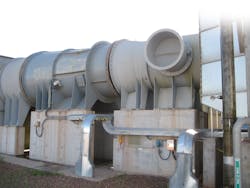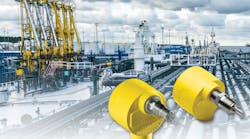HVAC and ventilation systems play a major role in chemical processing, pharmaceutical and food processing facilities, but these sophisticated units are often overlooked.
Many buildings, rooms and facilities in processing plants should be air-conditioned. There are many buildings, working areas or enclosures in these facilities that need a type of HVAC system. Some of them need sophisticated ventilation for temperature adjustments and other process and operational requirements, such as cleanliness and sterilization, and others may only need HVAC for personnel and operators working there. There are also enclosures and buildings where excessive quantities of heat are liberated, so they need special provisions to remove heat and to control the temperature.
HVAC
The goal of HVAC is to provide thermal comfort and acceptable indoor air quality. HVAC system design is based on the principles of fluid mechanics, thermodynamics and heat transfer. Ventilation is the process of exchanging air in a space to provide high indoor air quality, which involves temperature control, oxygen replenishment and removal of moisture, odors, smoke, heat, dust, airborne bacteria, carbon dioxide and others. Ventilation removes unpleasant smells and products, introduces outside air (after filtration), keeps interior air circulating and prevents stagnation of the air.
Fresh air makeup is needed for any air-conditioning system. It should be filtered, temperature-regulated and then properly fed to the indoor space, which provides a positive pressure in the buildings, rooms or enclosures. The exhaust air should be properly located so that exhaust will not be drawn into any air-conditioning air intake.
There are different codes and standards for HVAC systems; a common set of standards has been developed by the American Society of Heating, Refrigerating and Air-Conditioning Engineers (ASHRAE), which are widely used worldwide.
Chilled water systems
Packaged air-cooled chilled water units serving fan coils and fresh air-handling units are used in many industrial units and buildings such as control buildings, administration buildings and industrial indoors. In this system, the chilled water subsystem provides chilled water to the various HVAC air-handling units, which ensure a suitable temperature adjustment for buildings and rooms. In other words, this is a closed-circuit chilled water system that supplies chilled water to the various air-handling units at strategic positions and locations to minimize the amount of air ducting required.
Spare or standby water pumps are needed for the chilled water circuit. Some systems use 2×100% pumps, and others employ 3×50% pumps. Chilled water pumps are usually centrifugal, single-stage horizontal types. The chilled water is usually from service water of the plant and facilities; it needs makeup. A control valve system is often used for such a makeup of chilled water systems. The water in the closed-loop circuit could be contaminated, and its quality could be deteriorated. Chemical injection of suitable inhibitors and others are needed. In most cases, in parallel with the water pumps, a chemical dosing system is provided that will dose the pump suctions with the necessary chemical solutions and inhibitors to maintain the requisite quality of water in the circuit.
There are many types and models for packaged air-cooled water chillers — available in many different configurations and sizes. Air-cooled water chillers are usually fully packaged and factory-tested, comprising of two hermetic refrigeration compressors (one for operating and another for standby), two independent refrigeration circuits, air-cooled condensers, shell and tube-type evaporators, weatherproof enclosure and required control and instrument items.
A robust and high-performance control system is needed for any refrigeration package, including those for chilled water systems. This control system should automatically start and stop the unit and should control the unit cooling capacity in accordance with a signal from the chilled water subsystem.
Refrigeration compressors
Different types of refrigeration compressors are used in chilled water packages. Compressors are often hermetic scroll types with unloading capacity control arranged for efficient operation between about 25% and 100% of the rated capacity for small packages. Some packages use small-size reciprocating compressors for the refrigeration system. Large packages use screw compressors or even centrifugal compressors.
Condensers and evaporators
The condenser is usually an air-cooled type with proper construction materials. Some condensers use aluminum or aluminum alloys for optimal thermal performance, mechanical strength and reliability. The condenser coil block is usually mounted for vertical air discharge. The heat exchanger circuiting is arranged to give the correct amount of refrigerant liquid sub-cooling for efficient operation of the refrigeration system. Fans are needed for these air-cooled units. These fans are usually axial-flow type with contoured blades provided to deliver high air volumes at low tip speeds and with a minimum of noise and blade tip recirculation.
In most cases, evaporators are a shell-and-tube heat exchanger type. Refrigerant passes through the inner tubes. Pressure rating should be high with ample margins. As indications, a typical evaporator might be designed for 18 Barg working pressure on the refrigerant side (tubes) and 6 Barg on the chilled water side.
Air-handling units
The chilled water or, in some special cases, the refrigerant, is used in air-handling units to cool the air and deliver it to the indoors. The flow of chilled water through each air-handling unit is regulated by a proper control valve system, most often, a three-way control valve. This control valve is usually modulated by a temperature controller installed in the air system associated with a particular air-handling unit. However, many other different configurations for such control functions are used.
Air-handling units are provided with the necessary filter section, filters (bag filters, etc.), cooling coil, electric strip heater (if heating is needed), humidifier and air fans. Air-handling units are often provided close to the room or indoors to avoid substantial air ducting throughout.
Key role of filters
Different sets of filters are needed in air-handling units. Primary filtration equipment is selected with particular emphasis on large dust-holding capacity. There are different filter systems available for HVAC and air-handling units. Bag filters are usually selected as the primary filter. They can be large, even 1 meter in length or larger, and they should be multilayer media-type requiring no prefilters. These bag filter systems should preferably give an efficiency of more than 90%.
Filter media should preferably be vermin-proof (or equal), nonhygroscopic and flame-retardant. It should also be adequately supported to avoid distortion during operation. Usually, different washable panel filters and disposable filter systems are used to clean the air in different stages. The velocity at the filter should be low, and the air stream should be calm and suitable for filtration function. The filter panel should usually have a face velocity of less than 2 m/s. Disposable filter systems often have an efficiency of more than 95%. Other additional filters are mandatory in each specific industrial application to provide high-quality, clean air to the working areas.
Fans
Fans play a major role in an air-handling system and generally HVAC operation. They should deliver the required air volume flow rates at proper pressure to let the air flow pass through different stages with associated pressure drops and then deliver it to the intended indoor area.
Each fan should be properly selected with the rated point close to best efficiency point (BEP). The normal operating range should be well away from the points of overload. High-efficiency fans should be selected, as large volumes of air are handled in typical HVAC systems, and fan energy consumption is a critical factor. As indications, the efficiency of axial-flow fans should be more than 60% for the operating range and preferably more than 68% for the rated point. Mixed-flow fans should also reach a similar level of efficiency. In fact, for some sophisticated mixed-flow fans, efficiencies of 70% or more can be achievable.
Centrifugal fans are widely used in air-handling systems and, if selected properly, they present efficiency between 70% and 85% (or sometimes more). Sound attenuators are usually needed for fan systems. Flexible connections to ductwork are often provided for fan sets. However, care should be taken, as some of these have presented low reliability.
Makeup air intake ducting is needed for an air-handling system, and it is often arranged at roof levels of the buildings or enclosures. However, there are different layouts and configurations for such a system. Supply air is usually ducted to the various areas through ductwork and distributed through supply air diffusers. Air should be returned or extracted from rooms and buildings to make supply of air easier and more effective. Return air is usually extracted through ceiling-mounted return air diffusers. It is often returned to the air-handling unit by a duct-mounted centrifugal or axial fan. Alternatively, this fan may be incorporated within the air-handling unit.
Ductwork
Ductwork is needed in many different types of HVAC systems. This is required to guide and manage the flow of air to and from buildings, rooms and enclosures. Galvanized mild steel ductwork and fittings are usually used in HVAC systems. This is the standard, most common material used in the fabrication of ductwork. An advantage is the zinc coating of this metal, which prevents rusting and avoids cost of painting. However, in some applications, special painting for galvanized steels are used for better protection.
Aluminum ductwork is used in some applications. These are lightweight, easy to handle, slightly expensive, and often considered custom-made ducts used in special shapes and applications. Aluminum is also used to make round spiral ducts for some specific applications. Other materials are also used in special ductwork.
Access doors are usually provided on ductwork systems for cleaning, routine inspection and maintenance purposes. Test holes are also provided and necessary for commissioning and balancing the system.
Supporting of ducts is a major challenge for duct systems. All ductworks should be supported by strong supports suitable for the type and size of the duct. Flow management, pressure loss calculations, proper flow balance and careful sizing are needed for all ductwork. As an indication, velocity in main headers of air-conditioning supply ductwork is often 5 m/s to 7 m/s. For distribution and smaller ducts, velocities below 5 m/s are commonly used. Sometimes, even velocities around 3 m/s or 3.5 m/s might be used. Air velocities in return are usually lower than supply lines, often 2 m/s to 3.5 m/s.
Rectangular ductwork is commonly fabricated and used in many plants, buildings and applications. Round duct is also used in some applications, where the flow of air is better managed, therefore theoretically better. However, rectangular ducts are more widely available.
For insulation purposes, metal ducts can be lined with faced fiberglass blankets internally or externally if needed. In special applications, a double-walled duct might be used; this usually has an inner perforated liner and then a layer of fiberglass insulation (or similar). As rough indications, this layer is often 25 mm to 50 mm in thickness.
Volume control dampers are provided as necessary for regulation and balancing of air distribution systems and for shutoff purposes. Shutoff dampers should be airtight, and the air leakage through them should be less than 3% to 5% of the rated air flow in the duct at a maximum pressure differential as set up by the system fans. There are many different models and types for dampers. However, opposed blade dampers manufactured from stainless steel are common. Dampers should be suitably constructed to prevent distortion and jamming in operation.
Fire dampers are also needed to block the ductwork in case of fire; otherwise, HVAC duct network would help to propagate it. Fire dampers should also be provided where any duct passes through a fire barrier floor or fire-rated wall. These should have the same standard of fire resistance as the partition in which they are installed. These dampers should fit closely when shut. As a rough indication, these dampers should be able to resist fire for more than two or three hours.
There are different models of fire dampers. They may be hinged-single, multiblade or folded continuous shutter type. A commonly used model has a fusible link. In this type, fire dampers are held in the open position by a fusible link. In case of fire, the link is actuated, and it closes the damper. In addition, smoke detectors and other suitable fire sensors should be provided in supply and return ducts.



